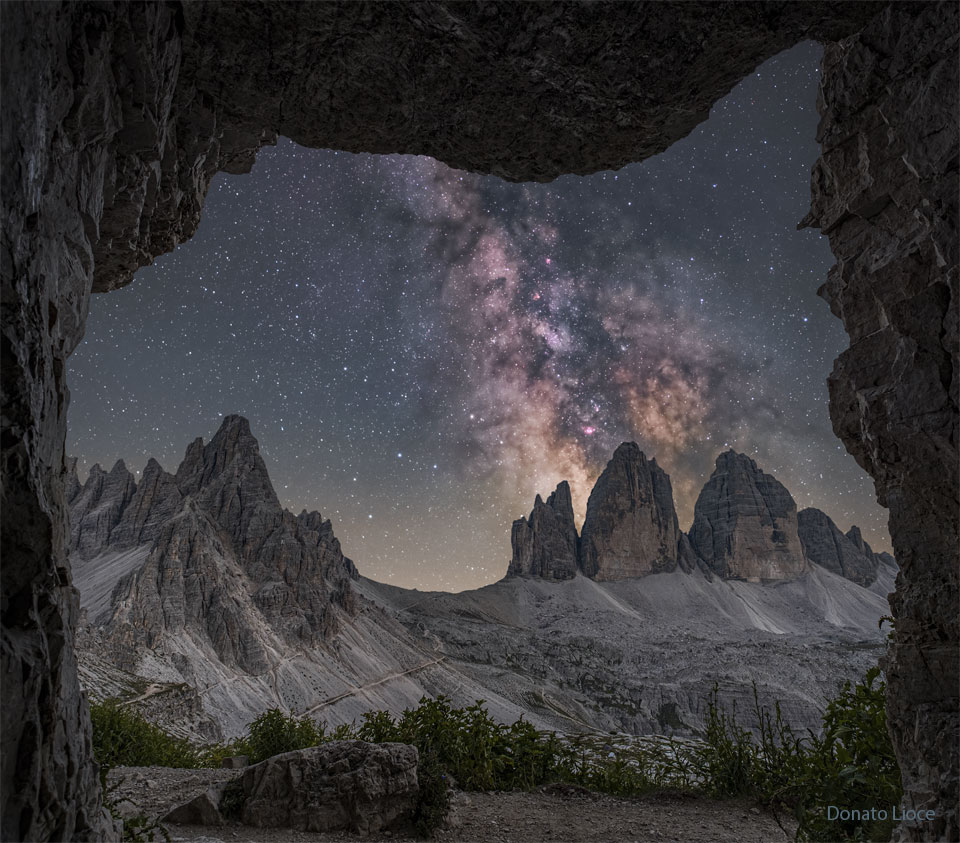Page 1 of 1
APOD: Milky Way Behind Three Merlons (2024 Aug 07)
Posted: Wed Aug 07, 2024 4:05 am
by APOD Robot
 Milky Way Behind Three Merlons
Explanation:
Milky Way Behind Three Merlons
Explanation: To some, they look like battlements, here protecting us against the center of the
Milky Way. The Three
Merlons, also called the
Three Peaks of Lavaredo, stand tall today because they are made of dense dolomite rock which has better resisted
erosion than surrounding softer rock. They formed about
250 million years ago and so are comparable in age with one of the
great extinctions of life on
Earth. A leading hypothesis is that this great
extinction was triggered by an
asteroid about 10-km across, larger in size than
Mount Everest, impacting the Earth.
Humans have gazed up at the stars in the
Milky Way and beyond for centuries, making these battlefield-like formations, based in the
Sexten Dolomites, a popular place for
current and
ancient astronomers.
Re: APOD: Milky Way Behind Three Merlons (2024 Aug 07)
Posted: Wed Aug 07, 2024 5:31 am
by Ann
Yes, I like it!

What I like best about it is that you could almost imagine that this image is not a composite image at all (it is, of course), because the faint light of the Milky Way could almost have illuminated the mountainscape on its own.
But you can actually tell from the color of the image that the foreground has not been photographed by the light of the Milky Way:
As you can see, the dominant light of the Milky Way is yellowish, but the (probably neutral-colored) slopes behind the Three Merlons are seen to be a mostly non-yellow shade of gray.
Anyway. The idea of the Milky Way as a light source on the Earth reminds me of the scarab beetles which roll their dung balls in straight lines at night by navigating by the stars. But because these little critters can't tell one star or constellation from another, they navigate by the light of the Milky Way.
Smithsonian Magazine wrote:
Science has shown us that a number of organisms use the stars for navigation: songbirds, harbor seals and, of course, humans. But a new study by a team of Swedish and South African researchers published today in the journal Current Biology indicates that a rather unexpected creature can be added to this list—the lowly dung beetle.
So I suppose that the
Arctic Tern, the wold's longest-flying migrating bird, does the same during its incredible journey from pole to pole every year. Navigate by the light of the Milky Way, I mean.
This bird over the Milky Way is not an Arctic Tern, but I was the best I could do.
Unless they are born knowing how to find Polaris in the sky, of course!

Ann
Re: APOD: Milky Way Behind Three Merlons (2024 Aug 07)
Posted: Wed Aug 07, 2024 12:01 pm
by Eric
Thank you for posting this nice image, Otto.
Copyediting note: The asteroid diameter should read "10 km", not "10-km". Hyphenation would be used for the adjectival form, e.g. "One day, the Vogons sent a 10-km asteroid to the Earth, and thereby saved the cetaceans from the humans".
Re: APOD: Milky Way Behind Three Merlons (2024 Aug 07)
Posted: Wed Aug 07, 2024 2:50 pm
by Roy
Following the link to the Permian extinction, we are given asteroid “as big as Everest” estimates from 6 to 12 km diameter. This ( V = 4/3 x pi x r*2 ) which calculates from 112.8 to 902.5 cubic kilometers, a wide range. Supposing it to be of granite, density ~ 2.7 grams per cc, the mass ranges from 3.05 x 10*11 to 2.44 x 10*11 tonnes.
Asteroids striking the earth move from 13.5 to 17 km/sec. Kinetic energy is e = mv*2. So low mass x low velocity estimate is 5,56 x10*13 ; high mass x high velocity is 7.05 x 10*14. Units are tonne x km*2 / sec*2, and I don’t know what that is, much less what 7 million billion of them are. Megatons, based on the force of detonating a ton of TNT is a totally inadequate comparison.
However, there is a 500 km wide crater in Wilkes Land thought to be contemporaneous with the Permian extinction, ICMYI.
Re: APOD: Milky Way Behind Three Merlons (2024 Aug 07)
Posted: Wed Aug 07, 2024 2:55 pm
by Roy
SB 3.05 x 10*11 to 2.44 x 10*12 tonnes.
Re: APOD: Milky Way Behind Three Merlons (2024 Aug 07)
Posted: Wed Aug 07, 2024 6:32 pm
by johnnydeep
Ann wrote: ↑Wed Aug 07, 2024 5:31 am
Yes, I like it!

What I like best about it is that you could almost imagine that this image is not a composite image at all (it is, of course), because the faint light of the Milky Way could almost have illuminated the mountainscape on its own.
But you can actually tell from the color of the image that the foreground has not been photographed by the light of the Milky Way:
APOD 8 July 2024 detail.png
As you can see, the dominant light of the Milky Way is yellowish, but the (probably neutral-colored) slopes behind the Three Merlons are seen to be a mostly non-yellow shade of gray.
Anyway. The idea of the Milky Way as a light source on the Earth reminds me of the scarab beetles which roll their dung balls in straight lines at night by navigating by the stars. But because these little critters can't tell one star or constellation from another, they navigate by the light of the Milky Way.
...
Ann
But the light of the MW is
behind those visible slopes! I suppose you're considering that the arc of the MW extends overhead and eventually
does illuminate those slopes?
Re: APOD: Milky Way Behind Three Merlons (2024 Aug 07)
Posted: Wed Aug 07, 2024 9:08 pm
by Christian G.
Beautiful image. All the realms are present, the biologic, the geologic, the cosmic…
As in this painting by Caspar David Friedrich, which somehow came to mind:
Re: APOD: Milky Way Behind Three Merlons (2024 Aug 07)
Posted: Wed Aug 07, 2024 10:01 pm
by Chris Peterson
Roy wrote: ↑Wed Aug 07, 2024 2:50 pm
Following the link to the Permian extinction, we are given asteroid “as big as Everest” estimates from 6 to 12 km diameter. This ( V = 4/3 x pi x r*2 ) which calculates from 112.8 to 902.5 cubic kilometers, a wide range. Supposing it to be of granite, density ~ 2.7 grams per cc, the mass ranges from 3.05 x 10*11 to 2.44 x 10*11 tonnes.
Asteroids striking the earth move from 13.5 to 17 km/sec. Kinetic energy is e = mv*2. So low mass x low velocity estimate is 5,56 x10*13 ; high mass x high velocity is 7.05 x 10*14. Units are tonne x km*2 / sec*2, and I don’t know what that is, much less what 7 million billion of them are. Megatons, based on the force of detonating a ton of TNT is a totally inadequate comparison.
However, there is a 500 km wide crater in Wilkes Land thought to be contemporaneous with the Permian extinction, ICMYI.
The formula for volume is with the radius
cubed, which you clearly used but didn't write above. A more realistic mass for an asteroid is probably around 1 gm/cm
3, but the much bigger factor with kinetic energy is the speed, of course. In this case it can range from a low of 11 km/s to a high of 72 km/s (much higher than the number you used). Taking the worst case situation for both speed and mass, we get a collision energy of around 10
25 J, or 2 billion megatons of TNT. Not a good day to be around.
Re: APOD: Milky Way Behind Three Merlons (2024 Aug 07)
Posted: Thu Aug 08, 2024 3:52 am
by Ann
johnnydeep wrote: ↑Wed Aug 07, 2024 6:32 pm
Ann wrote: ↑Wed Aug 07, 2024 5:31 am
Yes, I like it!

What I like best about it is that you could almost imagine that this image is not a composite image at all (it is, of course), because the faint light of the Milky Way could almost have illuminated the mountainscape on its own.
But you can actually tell from the color of the image that the foreground has not been photographed by the light of the Milky Way:
APOD 8 July 2024 detail.png
As you can see, the dominant light of the Milky Way is yellowish, but the (probably neutral-colored) slopes behind the Three Merlons are seen to be a mostly non-yellow shade of gray.
Anyway. The idea of the Milky Way as a light source on the Earth reminds me of the scarab beetles which roll their dung balls in straight lines at night by navigating by the stars. But because these little critters can't tell one star or constellation from another, they navigate by the light of the Milky Way.
...
Ann
But the light of the MW is
behind those visible slopes! I suppose you're considering that the arc of the MW extends overhead and eventually
does illuminate those slopes?
Well, I was thinking that the yellow light of the Milky Way should illuminate
some parts of the foreground and make it yellower in color than the parts that are in shadow. But it doesn't.
Ann
 Milky Way Behind Three Merlons
Milky Way Behind Three Merlons


